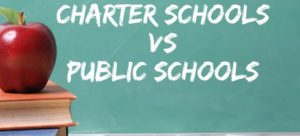
I find that there are two types of salesmen. Those who are committed to determining the customer’s needs and filling them; and those who determine what you need, then up-sell to something more expensive. These salesmen are committed to filling their own needs, and they do that by steering you to the more profitable item. They seem to offer choices, but they choose for you.
 It has been said that the education reform agenda is a giant bipartisan effort to destroy public education. I have believed that wholeheartedly until some time around mid-October of this year. I had been participating in ESSA forums and following research, and started taking note of some minute differences in the narratives of some of the major players. Then came president-elect, Donald Trump’s choice for Secretary of Education. Suddenly, the world tilted on its axis, and it became apparent that this isn’t a two-sided fight; but instead, a three-sided fight. I began to second guess what I believed to be true about education reformers. I had no choice but to seek out a reformer willing to answer my questions. So, I did.
It has been said that the education reform agenda is a giant bipartisan effort to destroy public education. I have believed that wholeheartedly until some time around mid-October of this year. I had been participating in ESSA forums and following research, and started taking note of some minute differences in the narratives of some of the major players. Then came president-elect, Donald Trump’s choice for Secretary of Education. Suddenly, the world tilted on its axis, and it became apparent that this isn’t a two-sided fight; but instead, a three-sided fight. I began to second guess what I believed to be true about education reformers. I had no choice but to seek out a reformer willing to answer my questions. So, I did.
I’m going to offer you a number of “what if” scenarios to consider, but before I do that, I want to make a few points.
- What happened in New Orleans, after Katrina, may or may not have been out of necessity. The system was laden with corrupt politicians and systematic inefficiencies, and it presented an opportunity to use New Orleans as a “proving ground” for choice. Katrina provided an opportunity; but no way did the school takeover result in “choice” for the parents of Orleans Parish. When the original system was dismantled, and the new system was brought in, they had no choice. The choice was made for them. When school zones are removed for the argument of choosing the school that fits you, the schools that are perceived to be the best, through attrition, fill up with the best students while the rest sit on waiting lists and attend the schools that are not the best. That isn’t choice. The choice was made for them. The decision to take that model statewide was ill-conceived and unnecessary.
- For years, we educators have been fighting and screaming about being demonized and labeled as failures because we know that while there are bad teachers in public schools, and there is much room for improvement within the public system, the vast majority of public school teachers are committed to the success of their students and are actually very good teachers. The reality is, if we expect reformers to accept what we are saying, we are going to have to acknowledge that not all reformers have the goal of destroying public education via privatization.
- Vouchers are not a form of choice. They violate the Constitution by subsidizing religion, and by design, make private schools, public. For this reason, they were found unconstitutional in 1958 in the state of Virginia.
I still believe that this has been a concerted effort between two very different political ideologies, but I now have a better understanding of how their goals, though somewhat different, have been able to coexist. With the recent election of Trump and his appointment of DeVos, that coexistence may come to an end. Here are a few things to consider moving forward.
 What if charter schools were only allowed to operate with the local board as a fiscal agent, but still maintained complete autonomy? The MFP funds and local funds could pass directly through the local board to the charter board, and the charter would be free to run the school as they see fit. In the event of poor performance or mismanagement, the local board can take over temporarily with no disruption to the student body, or the staff.
What if charter schools were only allowed to operate with the local board as a fiscal agent, but still maintained complete autonomy? The MFP funds and local funds could pass directly through the local board to the charter board, and the charter would be free to run the school as they see fit. In the event of poor performance or mismanagement, the local board can take over temporarily with no disruption to the student body, or the staff.
What if charter schools were not allowed to replicate, and/or replace, the public school setting? Instead, they would compliment the public school setting by offering a school design significantly different than the traditional setting that serves children with specific needs that the public system has not been able to meet. Parents would be able to make REAL choices about how their children are educated from schools that have more than just a different governance.
What if we acknowledge that a unionized workforce is not the problem with the public education system and direct our energies toward better training administrators in managing a workforce? Administrators who are trained on how to provide supports to deficient teachers, make strategic changes in teacher placement and take the necessary steps to ultimately remove a teacher, will be able to respond faster to the needs of the student.
What if we structured the professional ladder in a manner that each level builds upon the knowledge and skill of the previous level? If a teacher who wants to be a principal is required to receive training in managing a workforce, and a principal who wants to be a supervisor is required to receive training in education law and grant management, and a supervisor who wants to be a superintendent is required to receive training in finances and budgeting, the result will be a more efficiently run system with qualified people making decisions that affect our children.
What I have come to realize is that the bipartisan marriage between reformers has been a mismatch from the beginning. I believe that if the reformers who truly have the needs of children in mind had initiated conversations with the people who have been committed to the children, the privatizing reformers would have been stopped in their tracks. It is time for us to come together with a plan that will save public education; not eliminate it, and provide parents with REAL choices.

